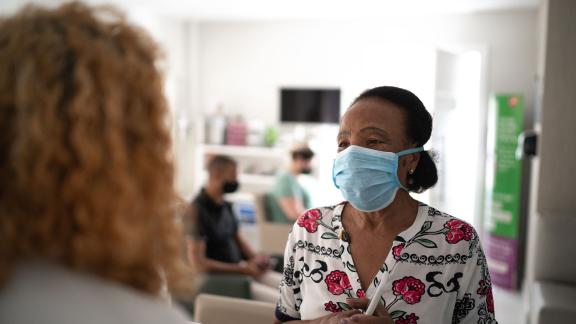PHE review on disparities in the risk and outcomes of COVID-19

Public Health England (PHE) has published the findings of a review into disparities in the risk and outcomes of COVID-19. The review was announced following emerging evidence suggesting a disproportionate impact on people from black and minority ethnic (BME) backgrounds.
Key points
- The review is a descriptive look at surveillance data on the impact of COVID-19 on risk and outcomes.
- The review confirms that the impact of COVID-19 has replicated existing health inequalities and, in some cases, exacerbated them further, particularly for black, Asian and minority ethnic (BAME) groups.
- The largest disparity found was by age. Among people already diagnosed with COVID-19, people who were 80 or older were 70 times more likely to die than those under 40.
- Risk of dying among those diagnosed with COVID-19 was also higher in males than females; higher in those living in the more deprived areas than those living in the least deprived; and higher in those in BAME groups than in white ethnic groups.
- These inequalities largely replicate existing inequalities in mortality rates in previous years, except for BAME groups, as mortality was previously higher in white ethnic groups. These analyses take into account age, sex, deprivation, region and ethnicity, but they do not take into account the existence of comorbidities, which are strongly associated with the risk of death from COVID-19 and are likely to explain some of the differences.
- When compared to previous years, the review also found a particularly high increase in all cause deaths among those born outside the UK and Ireland; those in a range of caring occupations, including social care and nursing auxiliaries and assistants; those who drive passengers in road vehicles for a living including taxi and minicab drivers and chauffeurs; those working as security guards and related occupations; and those in care homes.
- These analyses do not take into account the existence of comorbidities, which are strongly associated with the risk of death from COVID-19 and could explain some of these differences.
- The terms of reference for the report indicated that there will be recommendations as part of the review, however, this has not been included. What must happen quickly now is the full publication of the recommendations for action that need to follow in order for these inequalities to be addressed.
Background
The NHS Confederation’s BME Leadership Network published a briefing in April 2020 exploring the emerging evidence on the impact of COVID-19 on BME communities and health and care professionals. It provided a set of immediate actions for local and national NHS organisations to take to mitigate risks to patients and staff.
BME groups generally have less access to high-quality care along with poorer health and worse health outcomes than the overall population. For example, the risk of developing diabetes is six times higher in some BME groups. COVID-19 has shone a spotlight on health inequalities that have existed for several decades. Comorbidities and socio-economic status are being put forward as possible explanations for the high number of people from BME backgrounds affected, but it is important not to assume that correlation equals causation. Discrimination and racism also play a part in factors driving health inequalities, as evidenced globally.
The government announced various reviews looking into the issue, including this investigation by PHE. The Office of National Statistics (ONS) also found that the risk of death related to COVID-19 is significantly higher among some ethnic groups than it is for those of white ethnicity. NHS England and NHS Improvement are also leading work on the impact of COVID-19 on the BME workforce in the NHS.
Key findings
Ethnicity
The review found that the rates of death due to COVID-19 were higher for those from BAME groups in comparison to White ethnic groups. Those from Bangladeshi backgrounds were at twice the risk of death in comparison to those from a white British background. When comparing the death rates to previous years, mortality rates were lower than currently found in BAME groups.
It is important to note that the analysis undertaken did not take into account links to ethnicity and occupation, comorbidities or obesity. However, it does highlight that the relationship between health and ethnicity is complex and flags that the increased risk of acquiring the infection is linked to people of BAME backgrounds more likely to live in urban areas, overcrowded households, in deprived areas or work in job roles that could expose them to higher risk. It also mentions barriers such as access to services or language differences.
Comorbidities
Diabetes was referenced in 21 per cent of COVID-19 deaths and hypertensive disease also featured highly. The proportion was higher in all BAME groups when compared to White ethnic groups and was 43 per cent in the Asian group and 45 per cent in the black group. The same disparities were seen for hypertensive disease. The report also discusses the need to better understand the link to obesity and COVID-19. Further work is needed in this area to understand the relationship between the different diseases better.
Occupation
The report discusses some occupations which may mean that some people were in close proximity to others so at more at risk of infection, often on a daily basis. This comprises healthcare workers, including those from the nursing profession and social care, but also those working in transport, retail and construction.
Age and sex
Despite making up 46 per cent of diagnoses, men made up 60 per cent of deaths due to COVID-19, as well as 70 per cent of admissions to intensive care units. Diagnosis rates were found to be higher among females under 60, and higher among males over 60. Men of working age who were diagnosed with COVID-19 were more likely to die from the virus than women. Those aged 80 and over who tested positive were 70 times more likely to die compared to those under 40. The review reports that it is not clear what the differences in outcomes between men and women can be attributed to.
Geography
The review found that the burden of disease and mortality attributed to COVID-19 was not evenly spread across the country, with London found to have the highest rates of COVID-19 diagnoses and deaths. This was followed by the North West, the North East and the West Midlands and the lowest rates found in the South West. Other notable findings include that more females in the North West and North East were diagnosed in comparison to the rest of the country.
Deprivation
People who live in deprived areas are more likely to be diagnosed and then have a poorer outcome following the diagnosis compared to those who live in less deprived areas. These poorer outcomes still remain after adjusting to account for ethnicity. The report states that the higher diagnosis rates could be attributed to being in closer proximity to infections or taking account of exposure due to people’s job roles, however underlying health conditions needs more investigation.
Care homes
The report also discusses the greater number of deaths in care homes, including 2.3 times the number of deaths over a six-week period than expected when compared to previous years, which equates to around 20,457 excess deaths.
Inclusion health groups
The report discusses the increases in deaths for people born outside of the UK and Ireland, as well vulnerable migrants and those who are homeless. These groups tend to have the poorest health outcomes in society which means the end up in the extreme end of the gradient of health inequalities
The full report can be found on the PHE website.
NHS Confederation viewpoint
The impact of COVID-19 on black and minority ethnic communities and healthcare staff has highlighted racial inequalities and some of their root causes. This report is an important first step and confirms much of what we already know. But what must happen quickly now is the full publication of the recommendations for action that need to follow in order for these inequalities to be addressed.
There is much we still do not know and these figures do not take account of comorbidities which may well explain some of the differences. Working-age men are twice as likely to die than working-age women, while by far the biggest differential factor is age – those who are in their 80s are 70 times more likely to die than those under 40.
But race is clearly a significant factor even if we cannot explain all the reasons why this may the case. It is striking that people of Bangladeshi background had twice the risk of death than white people and African Caribbean people having up to 50 per cent the number of deaths. More research is needed to understand the impact of COVID-19 on known inequalities. We also do need to know more about the larger number of deaths among a range of lower paid caring occupations, including social care, nursing auxiliaries and assistants.
That is one of the reasons why we should all welcome the creation of the NHS Race and Health Observatory, which the NHS Confederation will be hosting. It will identify and help to tackle the disproportionate effects that race can have on patients, communities and staff.
For now, health and care organisations are putting in place practical measures to risk assess their staff and we have issued guidance to support this. This should include whether to put in place shielding measures and making sure there is adequate protective equipment available at all times
Our BME Leadership Network is playing a leading role developing and sharing practical actions NHS leaders and boards can take to support BME communities and staff. This includes publication of a briefing for leaders on the issue, which called for consideration to be given to make a change to death certificates so that ethnicity is recorded. In doing so, more accurate data can be collected to drive changes and improvement. The network has also submitted evidence to the Women and Equalities Select Committee inquiry looking at the impact of the pandemic on people with protected characteristics.
We will continue to support our members on this issue, including as part of the NHS Reset campaign. The campaign aims to contribute to the public debate on what the health and care system should look like post COVID-19.
It will support leaders to:
- Recognise both the sacrifice and achievements of the health and care sector’s response to COVID-19, including the major innovations that have been delivered at pace.
- Rebuild local service provision to meet the physical, mental, and social needs of communities affected by severe economic and social disruption.
- Reset our ambitions for what the health and care system of the future should look like, including its relationship with the public and public services.
Our themes for the campaign span a range of issues affecting how health and care services are planned, delivered and experienced across the UK. This includes looking at health inequalities and exploring how the health and care sector can help to address the geographic, socio-economic and socio-demographic inequalities exposed by the pandemic.
Find out more on our website and get involved in the campaign: www.nhsconfed.org/NHSReset


